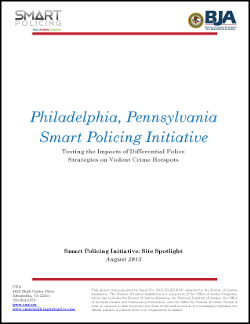
Despite the popularity of hotspots policing and the evidence on its effectiveness, there is surprisingly little research on what police officers should do in high-crime hotspots. The Philadelphia Police Department (PPD) and its research partners in the Department of Criminal Justice at Temple University sought to test the impacts of differential police strategies employed at violent crime hotspots, using a randomized controlled design. Together they identified 27 hotspots to receive foot patrol, another 27 to receive problem-oriented policing, and 27 more to receive offender-focused policing. Within each strategy the researchers randomly assigned 20 hot spots to receive the treatment and seven to act as control hotspots. The PPD implemented the interventions over a period of four to seven months in 2010-2011, and the research partners used advanced multi-level analysis to assess the impact of each strategy on violent crime in the targeted hotspots.
With regard to foot patrol, each District Captain was given discretion to determine how foot patrol would be implemented within their assigned deployment areas as long as each target area was patrolled a minimum of 8 hours a day, 5 days a week, for 12 weeks. The problem-oriented policing strategy consisted of teams of district officers, working in collaboration with community members and with the support of personnel from police headquarters identifying, analyzing, and implementing strategies targeting specific problems. The offender-focused strategy used Criminal Intelligence Unit (CIU) officers to identify repeat violent offenders who either lived in the target area or were suspected of being involved in violent crimes there. Team members and patrol officers frequently made contact with these prolific offenders using a variety of strategies.
Results showed that the offender-focused strategy outperformed both foot patrol and problem-solving strategies. Compared to the control areas, the treatment areas that received the offender-focused strategy experienced a 22-percent decrease in violent crime, and a 31-percent decrease in violent street felonies. No significant crime declines occurred in the areas that received problem-solving or foot patrol.
The success of the offender-focused strategy suggests that by focusing police efforts on the “problem people” associated with “problem places,” police can achieve significant crime reductions while avoiding negative community perceptions of their actions. Results also show that more complex strategies—such as problem solving—may not generate crime reduction benefits as quickly as offender-focused strategies. Last, results from two recent foot patrol experiments in Philadelphia raise interesting questions about the optimal conditions for implementation of foot patrol and potential minimum crime thresholds for producing successful crime control.
